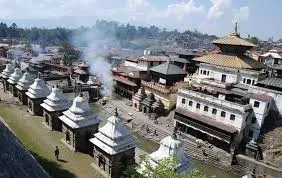

Pashupatinath: A Must-Visit for Every Spiritual Seeker
Nestled along the sacred Bagmati River in the vibrant city of Kathmandu, Nepal, the Pashupatinath Temple is an extraordinary pilgrimage site revered by Hindus worldwide. Its spiritual ambiance, historic significance, and architectural grandeur make it an essential destination for seekers of peace and enlightenment.
Unraveling the History of Pashupatinath Temple


The Pashupatinath Temple boasts a history that spans centuries. According to legend, Lord Shiva, the supreme deity of Hinduism, appeared in the form of a divine bull (Nandi) at this very site. Over time, a magnificent pagoda-style temple was constructed, becoming one of the oldest Hindu temples in Nepal. This UNESCO World Heritage Site has been a spiritual hub, drawing sages, devotees, and travelers seeking divine blessings.
Why Visit the Pashupatinath Temple?


- Spiritual Significance
The temple is dedicated to Lord Shiva, the “Pashupati” or Lord of Animals, symbolizing the interconnectedness of life. The sacred rituals performed here, especially the evening aarti, create an awe-inspiring spiritual experience. - Architectural Marvel
The temple features an exquisite two-tiered golden roof, intricate wooden carvings, and a silver-plated main entrance. The serene Bagmati River, flowing nearby, adds to the divine aura. - Cultural Immersion
Pashupatinath is not just a temple; it is a living cultural heritage site. Observing the daily rituals, sadhus (holy men) in meditation, and cremation ceremonies along the Bagmati offers a profound understanding of life and spirituality.
Planning Your Visit
Best Time to Visit Pashupatinath Temple
The temple is open year-round, but the ideal time to visit is during Shivaratri (February-March), when grand celebrations take place. The months of October to December are also favorable due to pleasant weather.
Pashupatinath Temple Timings
- Open daily: 4:00 AM – 9:00 PM
- Morning rituals: 4:00 AM – 12:00 PM
- Evening rituals: 5:00 PM – 7:00 PM
Pashupatinath Temple Entry Ticket Cost:
- Free for Indian Citizens
- NPR 1000 for Foreigners and Residents of SAARC Countries (Except India)
How to Reach Pashupatinath Temple
- By Air: The temple is a mere 4 km from Tribhuvan International Airport, Kathmandu.
- By Road: Local buses, taxis, and private vehicles offer convenient access from any part of Kathmandu city.
- By Train: While Nepal lacks a railway network, the temple is accessible via road routes from neighboring Indian cities.
Accommodation Options Nearby
Plenty of hotels and guesthouses cater to all budgets near the temple. Popular choices include Hotel Shanker, Kantipur Temple House, and budget-friendly hostels for backpackers.
Essential Tips for Visitors
- Respect local customs and dress modestly.
- Photography is restricted inside the main temple premises but permitted in the outer courtyard.
- Purchase entry tickets at the official counter: prices vary for locals and foreign visitors.
Cultural Importance and Reviews
The Pashupatinath Temple receives glowing reviews for its serene ambiance and cultural richness. It serves as a window into Nepalese traditions, rituals, and religious practices. Visitors often describe their experience as both humbling and transformative.
For art enthusiasts, exploring Pashupatinath Temple drawings and its intricate carvings provides immense inspiration. Whether you are a history buff, a devout pilgrim, or a curious traveler, this sacred site offers something profound for everyone.
Conclusion
A visit to the Pashupatinath Temple is more than just a journey; it is an immersion into a world of faith, tradition, and divine serenity. Whether you seek spiritual solace or wish to marvel at the temple’s heritage, Pashupatinath is an experience that will stay etched in your heart forever.
So, pack your bags, plan your visit, and prepare to be mesmerized by the timeless charm of Pashupatinath Temple, Nepal.
